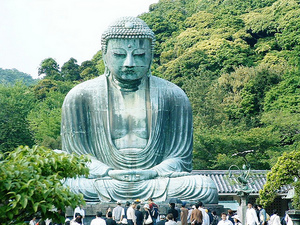Kamakura Daibutsu
- Built: 1252-?
- Designation: National Treasure
- Japanese: 鎌倉大仏 (Kamakura daibutsu)
The Kamakura Daibutsu, or "Kamakura Great Buddha," is the second-largest bronze statue of the Buddha in Japan, and the only Buddha sculpture in the city of Kamakura to be designated a National Treasure.[1] Depicting Amida Nyorai, it was constructed of multiple pieces of bronze, and is housed at the temple of Kôtoku-in.
The monk Jôkô, who had traveled the country collecting contributions, began construction of a wooden Great Buddha sculpture, and the Great Buddha Hall to house it, in the 3rd month of 1238; the eye-opening ceremony was held on 1243/6/11. This wooden sculpture was lost in a great storm in 1247, and construction began on a bronze replacement in 1252; it is this bronze sculpture which survives today.[2]
Little is known about the sculptor (designer) of the Great Buddha, but stylistically it shows strong influence from Song Dynasty Chinese Buddhist sculpture, and from the Kei school of Japanese sculptors.[3] The bronze for the sculpture was likely obtained by melting down Song Dynasty coins; the statue shares the exact same alloy content as Song currency.[4]
The sculpture was originally located indoors, within a wooden daibutsuden, or "Great Buddha Hall," but the hall was severely damaged by storms in 1335 and 1369; a tsunami destroyed the hall in 1498, leaving the statue nearly completely undamaged. The statue has remained open to the sky since that time.[2] The 1923 Great Kantô Earthquake caused the Daibutsu to shift two feet, but then too it remained undamaged.
Visitors are allowed to enter inside the great hollow sculpture for a small fee, providing a unique view of how the sculpture was assembled. Like the Nara daibutsu at Tôdai-ji, it was made by piling tons of earth around a mold, allowing workers to then climb atop the earthen mound to pour molten bronze in from above. Numerous layers, or piece-molds, were used, so that at the end, the Buddha was completely encased in a massive pile of dirt created to allow workers to get up high enough to pour the last sections (i.e. the head). The dirt and molds were then removed, leaving only the cooled, hardened bronze. From inside the Buddha, the seam where the top part and the lower part, cast separately, were then joined, is clearly visible. Also visible is a part of the inside of the neck which looks like it has been painted with clay - the result of a strengthening, a conservation effort, in 1960, using a kind of plastic or resin.[5] Considerable sections of the sculpture may have been gilded; traces of gilding remain on the cheeks.[3]
After the statue separated from its base and moved in the Great Earthquake, base-isolating quake protection was installed. No matter how great an earthquake, the statue will now never fall off its base, or fall over. It is the first Japanese Cultural Property to be repaired using plastic, and to have this type of base-isolating quake protection installed.[5]
The Kamakura Daibutsu is:
- 13.35 meters tall (including the base)
- 11.312m tall (not including the base)
- 121 tons in weight.
- Its face is 2.35m wide.
- Its eyes are each one meter wide.
- Its mouth is 82 cm wide.
- Its ears are each 1.9m long.
- Its urna is 18cm in diameter
- Each whorl of hair is 18cm tall, and 24cm in diameter
- There are 656 whorls of hair.[3]
References
- ↑ Butsuzô Kôtoku-in Amida." Kamakura-burabura.com.
- ↑ 2.0 2.1 "Kôtoku-in (Kamakura Daibutsu)." Kamakura-burabura.com.
- ↑ 3.0 3.1 3.2 "Kamakura daibutsu no tokuchô." Official website of Kôtoku-in. 2010.
- ↑ Richard von Glahn, "The Ningbo-Hakata Merchant-Monk Network And The Reorientation Of East Asian Maritime Trade 1150-1300," talk given at UC Santa Barbara Confucius Institute, 17 May 2018.
- ↑ 5.0 5.1 Plaques on-site.
